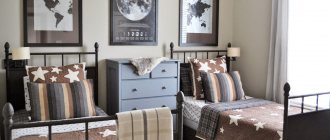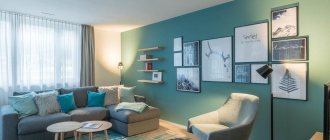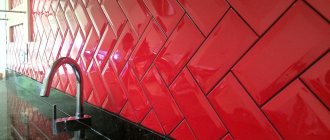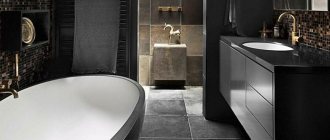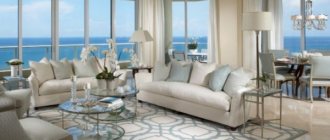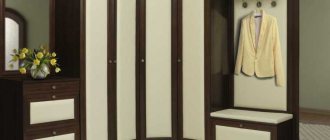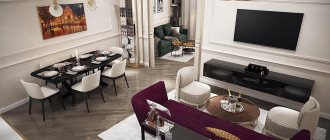Many designers prefer not to leave the corners of the apartment unfinished and add unusual solutions to the interior for this part of the apartment. For others, decoration can serve as protection if there are animals or small children in the house. Fragile corner wall upholstery requires attention and additional protection. Therefore, this article addresses the question of how to design the corners of walls in an apartment; there are also photo examples.
One of the most problematic areas in interior decoration are external corners.
In what cases is it necessary to finish corners in an apartment?
There can be many reasons for using such a building material. At the same time, each one has a different result of their work. But most often this is due to the need to align the corners in the apartment. Unfortunately, builders often encounter such an oversight and have to carry out an additional stage of renovation to make the room visually complete.
Decorative corners help solve these problems.
To make the correct geometric shape, you need to prepare the working surface. To do this, the previous covering is removed: wallpaper, whitewash, plaster. Next, the builders carry out treatment in the form of spraying with an antiseptic and cover it with a new layer of primer.
The corner protects the surface from mechanical damage, allows you to hide some flaws in the finishing, create a transition from one material to another, and cover the ends of tiles or panels.
Using a special corner, which is sold in every professional hardware store, the required shape is set at the corners of the walls. At the same time, time is spent measuring the deviation and evenness of the resulting surface. At the end of the work, special metal fasteners are glued to the corner and additionally treated with a new layer of finishing.
There are many options for using corners in the interior.
After performing minor construction manipulations, the angle is completely leveled and the desired visual effect is achieved. In difficult cases, absolutely any finishing materials can be used: from plastic panels to plasterboard elements.
Some difficulties arise when finishing corners other than 90°; this requires special, so-called. folding, corners.
In addition to the purpose of leveling the surface, these construction works are carried out to decorate the surface. A wide range of materials allows you to play up corners and make them real elements of the overall interior concept.
They can be used to decorate both external and internal corners of walls.
Decorating corners in an apartment involves the use of various decorative elements. This allows you to achieve completeness and aesthetic appeal. In addition, such manipulations are used to save space.
Corners can serve as niches for built-in furniture or be completely cut out to create seating areas.
The influence of using corner finishing in an apartment
Different options for finishing corners are accompanied by corresponding purposes. So, if there are small children or animals in the apartment, then the corners are treated for additional protection. A sharp impact can deform the desired shape and spoil the interior.
Their use in this case protects the end of the slope from damage and prevents the wallpaper from peeling off, which quite often happens on external corners.
Fans of unusual design prefer non-standard design of corners. This could be built-in furniture or arrangement of additional space. Various building materials can be used as finishing to influence the interior.
Great idea for saving space in your hallway.
Protect corners from damage
For protection, special protective corners are used. They differ from each other not only in the method of fastening, but also in the place of application.
In addition to technical, the corner profile also carries an aesthetic load.
The range of such products includes the following variations.
- By visual differences. Protective corners come in different shapes and shades, which allows them to combine two functions at once: aesthetic and protective. This way you can choose options to match the walls, doors, and baseboards. For a more unusual design, you can use different textures and eye-catching colors.
- According to the material used. A cheaper option is a plastic product. It comes in different colors, textures and even models with a transparent base. Metal options are more for protection than aesthetic appeal. To add a special touch to the room, you can use wooden options. In construction markets there are corners made of different types of wood and with different surfaces.
- Form. According to this criterion, two types of products are distinguished: sharp and round. You can choose any shape of protective corners. The parameter does not affect the main function. It's more a matter of aesthetic appeal.
- Dimensions. You can choose completely different dimensions. It all depends on the scale of the room and the walls as a whole. The largest option is considered to be a product measuring 10mm x 10mm x 2.75 m. The minimum size is 5mm x 17mm x 2.5m.
The use of a white corner completes the window opening.
Style Features
Despite the fact that photo wallpapers, in most cases, are intended for gluing on one of the walls of the room, they can also be used in a corner. With the right approach, corner photo wallpaper on two walls can be used very effectively. Of course, such an arrangement will not be successful for every plot. However, the distortion that appears when sticking any photo in such a place can be presented in such a way that from an obvious minus it can turn into a clear plus and even become a special “highlight” of the room.
An interesting feature of corner photo wallpapers on the wall (photos of many versions of which are presented in the galleries of this article) is that such solutions can be used not only for internal, but also for external corners. If we talk about external corners, then by using photo wallpaper in these places of the room, it becomes possible to visually “smooth out” them, and create the visual illusion that the corner is rather one of the parts of the wall, and not something that protrudes from her. At the same time, it should be understood that the optimal shades for solving problems of this type are soft, calm and neutral tones.
Attention! The use of this design technique helps to at least partially disguise some of the shortcomings of the internal space in the room.
By the way, the use of corner photo wallpaper can be especially appropriate in those corners that are not straight (90 degrees), but sharp or, conversely, obtuse. However, you need to remember that in such places it is advisable to use wallpaper with some kind of patterns, and not with straight lines. The fact is that in such cases they will only aggravate the situation by exposing obvious shortcomings, so to speak, “for show.” Therefore, it is better to abandon stripes, both vertical and horizontal, as well as contrasting images. The best solution would be to choose something neutral that visually smoothes out the protruding corners.
Related article: DIY cardboard table: tabletop, legs, finishing
By the way, in such cases, photo wallpapers with different colors can be an excellent option. To better familiarize yourself with them, you can look at ideas for wallpaper design with roses, as well as daisies and tulips.
Visual impact on the interior
The use of corner finishing will achieve several goals at once:
- alignment of the angle for the visual perception of a flat surface;
- performing not only an aesthetic function, but also a protective one;
- reducing contamination in hard-to-reach areas of the ceiling and floor;
- wall decoration;
- saving space and installing additional furniture;
- improving doorways, window openings and joints between panels.
A profile that contrasts with the slope and wall decoration can create the desired color accent or become an independent original interior detail.
Depending on the material used, different decoration options can be achieved. Stone decoration will make any room unusual. Plastic materials will help achieve completeness and simplicity.
Silicone ones can perfectly complement children's rooms with their abundance of colors and high protective functions.
Designers prefer not to refine the corners, but to remove them. Thus, additional niches appear in place of the usual room walls. They are great for saving space, because other furniture and even household appliances are inserted there.
This “trick” in the interior can be used in bedrooms for bookshelves, in the hallway for shoes and in the kitchen for appliances.
Bold designers practice getting rid of corners. Instead, they will equip an additional recess where you can place:
- interior items: vases, figurines, figurines made of ceramics or glass;
- a relaxation space where you can add a reading table or easy chairs;
- pet houses;
- small home libraries or shelves with magazines.
The corner of the room can be transformed into a practical shelf for books and souvenirs.
Additional Information! In addition to the above, recesses can be used for other purposes. Fantasy knows no bounds and you can come up with any options for convenience and comfort in the apartment.
Design features
In order for corner photo wallpaper on two walls to look harmonious and cope well with the main functions, it is necessary that at least the basic design rules are followed. What to do in such cases? What do you need to know to choose the right wallpaper for the corner of the room? In fact, there are several solutions, tips and recommendations. Let's look at the most popular ones:
- As noted a little earlier, an interesting solution could be the use of floral motifs.
- For right angles equal to 90 degrees, you can use contrasting pictures or images in which dark tones are combined with light ones.
- If we are talking about a small room with dark walls or insufficient natural sunlight, it is advisable to use the brightest possible options for photo wallpaper for the corners. Any designer who deals not only with interiors is well aware that light and bright colors have such a feature as visual expansion. Dark shades, on the contrary, visually narrow.
- And finally, approximately the same can be said about the possibility of visually changing the height of the walls of the room. If, as they say, the ceiling is quite low, then it is best to glue photo wallpaper with something high. It could be a skyscraper, a tower, a lonely tree or something similar. On the contrary, if you need to create the illusion of a wider space in a small and narrow room, then it is advisable to use plots in which the main emphasis is on the “breadth” orientation. This could be: a wide sea bay, a field, sprawling bushes and other similar images.
Related article: Do-it-yourself chain-link fence
This is all about the subjects, images and choice of colors that are desirable in such places. If we talk about what is better not to use in such places, then the following points should be noted:
- A little higher, the possible benefits of using contrast when choosing a color scheme were noted. On the one hand, this is true. However, you should not overdo it, since such an image may not look attractive and harmonious, but a little naive and funny.
- You should also avoid gluing photo wallpapers with portraits.
- It is important to consider the height at which objects are pasted. You want them to look natural, positioned at your eye level and not too low or high.
Materials for finishing corners in an apartment
Decorating corners in an apartment with decorative corners is not an easy process. In this case, it is worth paying due attention to the choice of material. The general concept of the result depends on this.
The material of the corner determines its appearance, technical characteristics and scope of application.
Plastic panels
Such fittings are an inexpensive decorative material for finishing polyvinyl chloride (PVC). The building material is resistant to alkali and acids. Light weight greatly simplifies the installation process. Also, PVC panels do not require maintenance.
The palette of monochrome corners contains approximately 30 shades.
If cracks or deformations appear, you can easily replace the parts with new ones. At the same time, you will be pleased with the affordable price. A large range of products will allow you to choose the right dimensions, shades and even shape. Key advantages include moisture resistance and lightness.
If necessary, the white profile can be repainted in any other color.
Transparent silicone corners
An attractive and flexible material that has found its application in finishing bathroom corners. High resistance to water allows the product to be used in the humid environment of a given room. At the same time, the corners themselves are flexible, which allows them to be attached even on uneven surfaces.
If there is a need to protect the corner and preserve the wallpaper pattern, apply a silicone corner profile.
The main disadvantage is a weakness for household chemicals. Therefore, the process of caring for this protective product becomes more complicated. For cleaning, use non-aggressive chemicals or a regular damp cloth.
This material is quite soft and is well suited for rooms where small children are often present, because... reduces the risk of a child being injured by hitting a corner.
Builders prefer transparent silicone corners due to their ease of installation. The structure is attached by removing the protective film that covers the adhesive base. No additional equipment or mixtures are required for installation.
Decorative rock
This material will always remain a leader among other building materials in terms of aesthetic appeal. This option for decorating corners in an apartment will help create a special atmosphere and emphasize the unusual design solution.
It is best to decorate corners in an apartment with flexible stone.
This material is relevant for owners of large apartments. Since the decorative stone itself takes up quite a lot of space. In a small room, its installation is considered irrational.
Decorative stone in the corners will look very beautiful.
Key features include:
- strength;
- choice of different textures and shades;
- there are smooth and rough surfaces;
- resistance to physical influences;
- the opportunity to turn any design ideas into reality.
The use of stone is appropriate in apartments with a large area.
Drywall
A universal material that is widely used for finishing arches, shelves, ceilings, walls and any openings. The fragility of the material does not allow installation for the purpose of decorating a room. During installation, it is necessary to add an additional construction stage, which includes fixing the structure with putty or other mixtures.
Drywall is accessible and affordable.
Compound
If we talk about what material such wallpaper can be made from, it should be noted that there are not so many main varieties. And, as a rule, they coincide with the materials that are used in the production of ordinary roll wallpaper. So, here is a short list of them:
- Vinyl photo wallpaper. In fact, vinyl canvases are a fairly well-known trend in the wallpaper market. They have a significant number of advantages, including durability, the ability to carry out wet cleaning, and an attractive appearance. Among the disadvantages is poor air permeability. As for their composition, vinyl is only an outer, decorative layer. The base in such cases is made of non-woven fabric or paper.
- If we talk about non-woven photo wallpaper, then we must say that this is an excellent option at a competitive price. At the same time, you must understand that the interlining acts solely as a base for the vinyl or paper outer layer.
- Paper wallpaper is widely known for its environmental friendliness. In addition, the easiest way to glue them is with your own hands (just follow the instructions from the manufacturer). At the same time, the disadvantage is the short service life and the inability to carry out wet cleaning.
Related article: Multifunctional corner sofa with sleeping place for the kitchen
This is the basic information that I would like to provide about corner photo wallpaper for the interior. We hope that it will help you when renovating or decorating the interior of your room.

